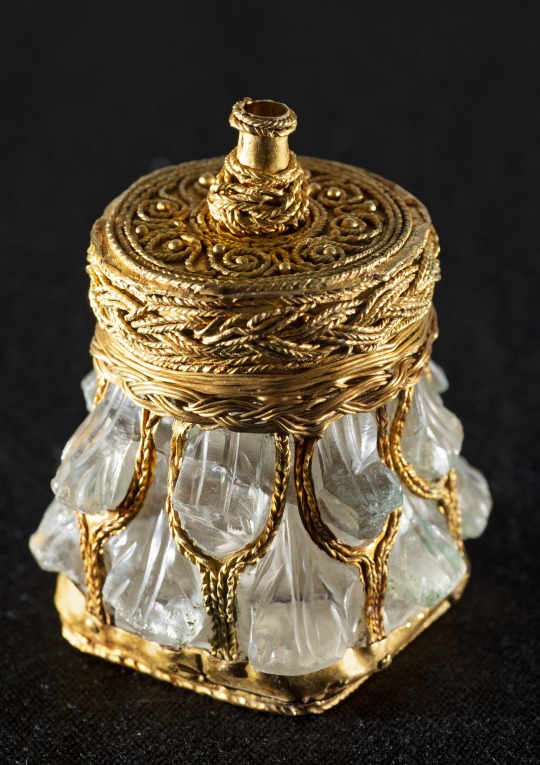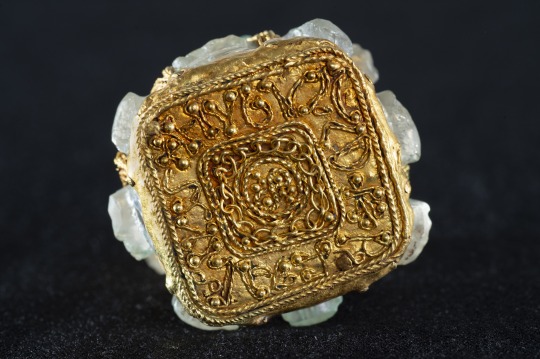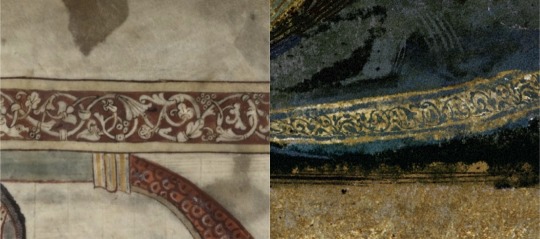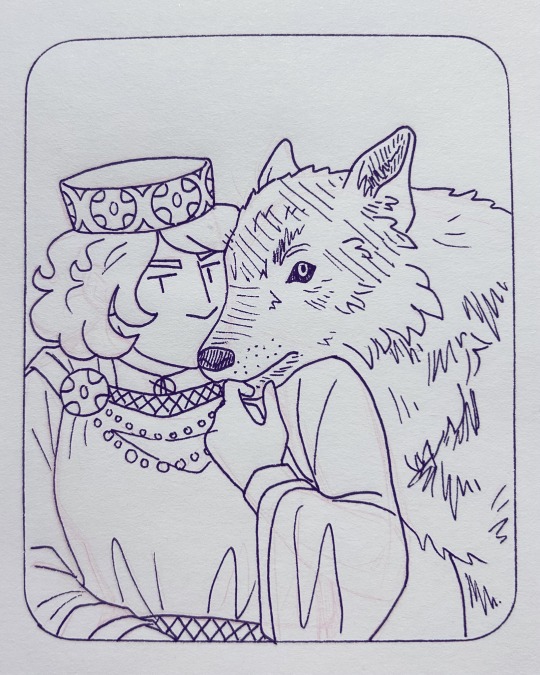#anglo Saxon England
Explore tagged Tumblr posts
Text


Hey Everyone! Look at this Gold and Rock Crystal Bottle from the Galloway Hoard!
In September of 2014 an avid metal detectorist named Derek Mclennan discovered one of the grandest historical finds in Scottish archaeological history. While searching on church lands near Balmaghie, Mclennan uncovered the Galloway Hoard, a viking age treasure hoard consisting of over 100 objects dating to around 900 AD. While the hoard has some gold objects, most are silver including pieces of jewelry, hack silver, and silver ingots.

Among the objects, the most incredible is a rock crystal bottle that is decorated with gold. The bottle was found inside of a silk pouch, the silk coming from either Byzantium or Asia. The crystal jar itself is not from the middle ages but is Roman and dates to the 4th century. Later in the early middle ages the jar was decorated in gold filigree, at the behest of Bishop Hyguald according to an inscription on the gold work. While the identity of "Bishop Hyguald" is unknown, it is thought that he mostly likely came from Northumbria, an Anglo-Saxon kingdom in northern England. Northumbria would be conquered and occupied by Danish Vikings in the 9th century, which explains how the bottle became a part of the Galloway Hoard.
Today, the bottle along with the rest of the Galloway Hoard is housed at the National Museum of Scotland
#history#antiquities#art#middle ages#medieval art#vikings#anglo saxon england#scotland#scottish history
922 notes
·
View notes
Text
"That Æthelswith was the bestower of such gifts is consistent with the other things we know about her. In 868 she witnessed a West-Saxon charter, in which she made a grant of fifteen hides of her own land in Berkshire. She also witnessed all of her husband King Burgred’s charters. Though we only see glimpses of her influence, Æthelswith, like other Mercian queens before her, was a politician.
In 874, twenty one years after Æthelswith married Burgred, the royal couple were forced out of their kingdom by an encroaching Viking army. They fled together to safety in Rome. While Burgred died soon after they arrived, Æthelswith outlived him for another decade, which she spent in Italy.
Queen Æthelswith passed away in 888 in Pavia, and was laid to rest there. She may have been undertaking a pilgrimage when she died. Her body and the ring that she once bestowed were both buried underground a thousand miles apart. And they say medieval women didn’t travel…"
#Æthelswith#history#women in history#women's history#9th century#english history#queens#leaders#english queens#anglo saxon history#anglo saxon england#medieval women#medieval history#middle ages#medieval#archeology
267 notes
·
View notes
Text

Day 15: Seaxburh, queen of Wessex. After the death of her husband Cenwalh, she ruled Wessex in her own right for over a year, possibly two. She is the only woman listed in the regnal list of the Anglo-Saxon Chronicle.
#grayjoytober2024#seaxburh of wessex#kingdom of wessex#historical women#history art#traditional art#medieval england#7th century#anglo saxon england#saxon tag#inktober#inktober 2024#drawtober#drawtober 2024
22 notes
·
View notes
Text
17 notes
·
View notes
Text






The first five kings of Wessex.
1. Cerdic, its founder (Tenure: 519-534).
2. Cynric, his son. (Tenure: 534-560).
3. Ceawling, his likely grandson (Tenure: 560-592).
4. Ceol, his other grandson (Tenure: 592-597).
5. Ceolwulf, his great-grandson (Tenure: 597-611).
#house of Wessex#angles#saxons#anglo saxon#anglo saxons chronicles#anglo saxon england#anglo saxons#medieval England#medieval chronicle#early medieval britain#middle ages#cerdic of wessex#cynric of wessex#fancast#Anglo-Saxon England edit#aesthetic
0 notes
Text
youtube
1 note
·
View note
Text
Mercia: Exploring the Heartland of Saxon England and Its Lasting Influence
Mercia: Exploring the Heartland of Saxon England and Its Lasting Influence #TalesOfMercia #Penda #Coelwulf #Æthelflæd #Leofwine #histfic #nonfiction #royalwomen
Having written more books than I probably should about the Saxon kingdom of Mercia, and with more planned, I’ve somewhat belatedly realised I’ve never explained what Mercia actually was. I’m going to correct that now. Having grown up within the ancient kingdom of Mercia, still referenced today in such titles as the West Mercia Police, I feel I’ve always been aware of the heritage of the Midlands…

View On WordPress
#Amazon#Anglo Saxon England#historical fiction#M J Porter#Mercia#Saxon England#Tales of Mercia#the kingdom of Mercia
0 notes
Photo
King Alfred the Great planning a church,
Alfred the Great c. 849 – 26 October 899) was King of the West Saxons from 871 to 886, and King of the Anglo-Saxons from 886 until his death in 899. He was the youngest son of King Æthelwulf and his first wife Osburh, who both died when Alfred was young. Three of Alfred's brothers, Æthelbald, Æthelberht and Æthelred, reigned in turn before him. Under Alfred's rule, considerable administrative and military reforms were introduced, prompting lasting change in England.
He is primarily remembered for his successful defense of his country against the Viking invaders.

22 notes
·
View notes
Text

Brooch (the so-called "Hanney brooch") of Anglo-Saxon (Kentish) manufacture, decorated with garnets set in bosses of a white material, perhaps shell. Made in the 7th century, the brooch was found in the grave of a woman between 20 and 25 years of age and would have been worn on her left shoulder. From Oxfordshire, England, UK; now in the British Museum. Photo credit: Ian R. Cartwright/The Portable Antiquities Scheme/The Trustees of the British Museum.
#art#art history#Dark Ages#Anglo-Saxon#Anglo-Saxon art#Anglo-Saxon England#artifacts#artefacts#jewelry#jewellery#brooch#7th century art#British Museum
586 notes
·
View notes
Photo

The Anglo-Saxon occupation of England
247 notes
·
View notes
Text

I shine only with the light you gave me. — The Moon Will Sing by The Crane Wives
INPRNT
-
This is a recreation of The Meeting on the Turret Stairs (1864) by Frederic William Burton. Credit to the wonderful @soulhollow for giving me the brilliant idea and commissioning this 💚
-
The costume design for Alfred

They said they wanted to see Alfred in purple/gold tones, so I self-indulgently designed a costume for Alfred (though again not necessarily trying to be historical accurate)
-
Details for archaeology nerds (So it happens again I guess)
1. The tablet-woven bend
Design is loosely taken from an actual archaeological find from the Taplow Barrow in Buckinghamsire, dating to the early 7th century. The original piece really had the gold threads on it by the way. You can see the modern reconstruction here.

2. Pattern on the tunic
Taken from a part of an arcade illustration in the Royal Bible (Royal 1. E. vi, 4r.) c. 1000-1025 in British Library, London. Added some vine patterns that are quite common to see in insular art for reasons.

3. Pattern on the shawl
Taken from a part of the stole and the maniple in St. Cuthbert’s coffin, dated to early 10th century, now in Durham Cathedral Museum.

4. Embroidery on Alfred’s sleeves
The pattern is from an illustration in the manuscript of Bede’s Life of St Cuthbert (MS 183, f. 1v) c. 937 in Parker Library, Cambridge, which depicts King Æthelstan showing the book to St Cuthbert himself.

-
The process
Such a pleasure to work on this one! Thank you again for giving me the chance✨
#can i just say i was basically smiling like a weirdo at my ipad the whole time i was working on this#sorry hahahah but I’m so honored to recreate one of my favorite paintings and drawing this somehow gave me life#oh and the flower on the floor is daffodils! saw somewhere that it represented chivalry so… :D#the last kingdom#tlk alfred#alfred x uhtred#uhtred x alfred#king alfred#alfred the great#alhtred#uhtred#hikaru tlk#hikaruchen#AND - if anybody happens to be in desperate need of visual references of Anglo-Saxon clothing or just simply wants to know more about it#check out Dress in Anglo-Saxon England by Gale R. Owen-Crocker#it’s extremely helpful
219 notes
·
View notes
Text

Virgin and Child, St Cuthbert’s Coffin, Durham Cathedral
Anglo-Saxon
The earliest surviving carved representation of the Virgin and Child in British art.
St Cuthbert’s coffin remains one of the most stunning pieces of Anglo-Saxon wood work in the country.
#english imagination#english culture#albion#england#art#english art#Anglo Saxon#wooden carving#madonna and child#virgin and child#Saint Cuthbert’s coffin#durham cathedral
126 notes
·
View notes
Text

One of the oldest Saxon churches in England - Escomb, Co. Durham
#Escomb#County Durham#Anglo-Saxon#Church of England#parish church#gravestones#sacred space#Bishop Auckland#slate roof#English history#Christendom#UK#AD 670-675
195 notes
·
View notes
Text

Day 28: Wolf - Aelfthryth, third wife of Edgar the Peaceful
#jenstober23#queen aelfthryth#edgar the peaceful#aethelred the unready#anglo saxon england#medieval england#saxon tag#wolf#10th century#history art#traditional art#inktober#inktober 2023#drawtober#drawtober 2023#artober#artober 2023#witchtober#witchtober 2023#day 28
14 notes
·
View notes
Text

The Boyhood of Alfred the Great by Edmund Blair Leighton
#alfred the great#osburh#osburga#mother#boyhood#art#edmund blair leighton#edmund leighton#wessex#anglo saxon#anglo saxons#history#english#england#middle ages#medieval#osburga oslacsdotter#education#christian#christianity#mediaeval#royal#royalty#royals#house of wessex
261 notes
·
View notes
Text
Scotland and England like to take digs at each other so often with shit like: 'Hey, remember when Edinburgh was part of Northumbria for 300 years?'
'Oh, sure. Remember how I saved your Princess Margaret from the Normans, and now she's a Saint? My saint. Not yours.'
'Oh, yes, her Englishness truly was divine. She's as Scottish as her kids Edward, Edmund, Ethelred, Edgar, and Edith. Such Scottish names - just like their dad Maol Chaluim would have wanted.'
'And remind me which one of those kids became a Queen of England and a better ruler than her dumbarse husband?'
'She married a Norman, of course he was a dumbarse. They're all fucking Norman - the Bruces and the Stewarts were Norman in case you forgot, and you caved in the second they came to settle in the lowlands.'
'Cause fighting them worked so well for you. Remember that time they killed everyone in your north?'
'Haha prick. Good times for you I'm sure.'
'Haha. It could have been better.'
Then they both kind of go man fuck the Normans and the conversation dies a quiet death.
#why are the normans fucking everywhere#south scotland you went through too much#are you anglo saxon are you pictish are you scottish and you byrthonic are you norman WHO KNOWS#also edith/matilda you will always be the best queen of that dynasty#that entire generation of scottish royals in general: AND IIIIIIIIIIIIIIIII~ WILL ALWAYS LOVE YOUUUUUU~#hws england#hws scotland#headcanon#hetalia#op
26 notes
·
View notes